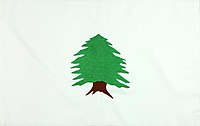User:Red Phoenician/Maronite flag

The Maronite flag was created in the 18th century with its first recorded use being in October 1848.[1] The flag was also raised as the first national flag of Lebanon on October 2, 1918 following the fall of the Ottoman Empire.[2]
History
[edit]
Under the ascension of the first Maronite emir of Mount Lebanon, Bashir Shihab II, the formation of a modern Maronite identity began to take place in the region. This attitude only continued to increase after the fall of the Shihabi emirs as Mount Lebanon was split into two separate Maronite and Druze districts. This caused a surge of both nationalism and animosity among the two groups which eventually culminated in the 1860 civil conflict in Mount Lebanon and Damascus
The 1918 version of the flag was created by two Lebanese Brazilian journalists, Shukri El Khoury and Naoum Labaki, who were both part of the Mahjar movement in the Americas. The flag was raised on October 2, 1918 following the expulsion of Ottoman troops from Mount Lebanon and was hung in the Administrative Council (Majlis) of Mount Lebanon until 1920 when the flag and government were succeeded by the state of Greater Lebanon.
The flag was also used by the second Lebanese delegation to the Paris Peace Conference (1919–1920), led by the Maronite patriarch Elias Peter Hoayek[3], to petition for an independent Lebanese state separate from the planned Arab kingdom of Faisal I.
Symbolism
[edit]The flag has a simple design with two main features
- The white background represents the snow of Mount Lebanon as a symbol of purity and peace.
- The cedar is based on the national symbol of the Maronite Christians, the Cedrus libani. The cedar of Lebanon is mentioned seventy-seven times in the Bible, especially in the book of Psalms chapter 92 verse 13 where it says that "The righteous shall flourish like the palm tree, He shall grow like a cedar in Lebanon"[4] and Chapter 104, verse 16, where it is stated: "[t]he trees of the Lord are well watered, the cedars of Lebanon that he planted".[5]
Gallery
[edit]See also
[edit]References
[edit]- ^ "Cedar Flag 1918 (Historical Flags, Lebanon)". crwflags.com. 2020-07-31.
- ^ "Flags and banners". lebarmy.gov.lb. Lebanese Armed Forces. December 2016.
- ^ "Lebanese Flag story". minbaladeh.world.
- ^ "The Bible". Retrieved 27 October 2014.
- ^ "The Bible". Retrieved 27 October 2014.
Text is available under the CC BY-SA 4.0 license; additional terms may apply.
Images, videos and audio are available under their respective licenses.

